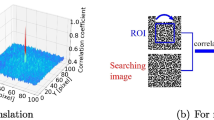Abstract
The projected contours of a rigid body in motion define a velocity field, a flow in the image plane, where the tangential components are invisible. We investigate robustness when estimating motion parameters from the normal components of velocity along contours.
Ambiguous curves are contours for which no unique motion can be recovered from normal flow. We show that they are field lines of some extra velocity field, which causes an invisible motion when added on top of the actual velocity field. (These field lines coincide with the contour.) This is an analytical description of what Waxman and Wohn (1984) called “the aperture problem in the large,” which actually was studied by Lie (1893) under the concept of “self-projective curves,” if we specialize to a planar surface patch. We make a catalogue of the class of ambiguous curves.
We study the robustness of motion parameters, obtained by least-squares estimation, by calculating the a mount by which noise (in the normal flow) is magnified. For simple curves and a motion model with four unknowns-two translation components, rotation and expansion-there are explicit formulas relating the robustness of motion parameters to how large a portion of the contour we use. Sometimes it helps to use more global information (a larger portion of, e.g., a closed contour), and sometimes there is no way out, because we are working with contour segments that too closely resemble ambiguous curves. Neither is there any hope to recover the true velocity field from normal flow locally, since any contour falls into one of the “ill-conditioned contours.”
Similar content being viewed by others
References
G.Adiv, “Determining 3-D motion and structure from optical flow,” Coins Technical Report 84-07, Univ. of Massachusetts at Amherst, April 1984.
S.Carlsson, and C.Reillo, “Contour based representation of the displacement field for motion compensated image coding,” Proc. ICASSP Conf., Tokyo, April 1986.
J.F. Canny, “Finding edges and lines in images,” TR No. 720, Artificial Intelligence Laboratory, Massachusetts Institute of Technology, Cambridge, MA., 1983.
J.F. Canny, “A computational approach to edge detection,” IEEE Trans. PAMI 8 (November 1986).
L.S. Davis, Z. Wu, and H. Sun, “Contour-based motion estimation,” Comput. Vision Graphics and Image Processing. 23:303–326, 1983.
E. Hildreth, “Computations underlying the measurement of visual motion,” Artificial Intelligence 23: 309–354, 1984.
H.C. Holland, The Spiral After-Effect. Pergamon Press: Oxford, 1965.
B.K.P. Horn, and B.G. Schunck, “Determining optical flow,” Artificial Intelligence 17: 185–203, 1981.
K.Kanatani, “Structure from motion without correspondence: General principle,” Proc. DARPA Image Understanding Workshop, Miami Beach, FL, pp. 107–116, December 1985.
J. Kmenta, Elements of Econometries. Macmillan: New York, 1971.
R.Lenz, “Estimation of general 2-D motion parameters in TV-scenes,” Proc. 7th Intern. Conf. on Pattern Recognition, Montreal, vol. I, pp. 546–548, 1984.
Lie Sophus, Vorlesungen über Continuerliche Gruppen, Chelsey Publ. Company, 1893.
D. Marr, and E. Hildreth, “Theory of edge detection,” Proc. Roy. Soc. London B-207: 187–217, 1980.
C. Reillo, and S. Carlsson, “Contour segment motion estimation,” TRITA-TTT 8506, Royal Institute of Technology, Stockholm, Sweden, November 1985.
M. Subbarao, and A.M. Waxman, “On the uniqueness of image flow solutions for planar surfaces in motion,” Center for Automation Research, Tech. Rept. CS-TR-1485, University of Maryland, College Park, April 1985.
R.Y. Tsai, and T.S. Huang, “Estimating three-dimensional motion parameters of a rigid planar patch,” IEEE Trans. Acoustics, Speech, and Signal Processing 29(6): 1147–1152, 1981.
R.Y. Tsai, T.S. Huang, and W.L. Zhu, “Estimating three-dimensional motion parameters of a rigid planar patch, II: Singular value decomposition,” IEEE Trans. Acoustics, Speech, and Signal Processing 30(4): 525–534, 1982.
G.Simmons, Differential Equations with Applications and Historical Notes. TATA McGraw-Hill Publishing Company Ltd, 1972.
H. Wallach, A. Weisz, and P.A. Adams, “Circles and derived figures in rotation,” Am. J. Psychol. 69: 48–59, 1956.
A. Waxman, and S. Ullman, “Surface structure and 3-D motion from image flow: A kinematic analysis,” CAR-TR-24, CS-TR-1332, Center for Automation Research, Univ. of Maryland, Artifical Intelligence Lab., MIT Cambridge, MA, October 1983.
A. Waxman, and K. Wohn, “Contour evolution, neighbourhood deformation and global image flow: Planar surfaces in motion,” CAR-TR-58, CS-TR-1394, April 1984, Center for Automation Research, Univ. of Maryland; also in Intern. J. Robotics Res. 4:72–94, 1985.
K. Wohn, L.S. Davis, and P. Thrift, “Motion estimation based on multiple local constraints and nonlinear smoothing,” Pattern Recognition 16(6): 563–570, 1983.
Author information
Authors and Affiliations
Rights and permissions
About this article
Cite this article
Bergholm, F. Motion from flow along contours: A note on robustness and ambiguous cases. Int J Comput Vision 2, 395–415 (1989). https://doi.org/10.1007/BF00133557
Issue Date:
DOI: https://doi.org/10.1007/BF00133557




